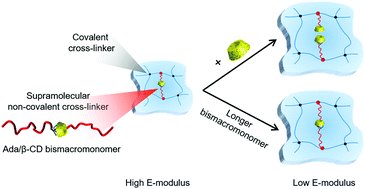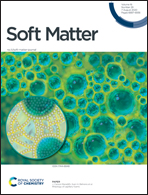Double cross-linked supramolecular hydrogels with tunable properties based on host–guest interactions†
Abstract
We report a novel double cross-linked hydrogel system based on polyacrylamide and poly(2-methyl-2-oxazoline) (PMOXA) network chains, as well as on supramolecular host–guest interactions with on-demand tailored mechanical properties. Well-defined vinyl-bearing PMOXA macromonomers, functionalized with either β-cyclodextrin units (β-CD–PMOXA) or adamantane units (Ada–PMOXA), were synthesized and confirmed using 1H NMR, MALDI-TOF-MS and GPC measurements. The complexation between adamantane and β-CD modified macromonomers in solution towards bismacromonomers was confirmed by 2D NOESY NMR and DLS. After introducing these bismacromonomers into the polyacrylamide hydrogel, the supramolecular non-covalent Ada/β-CD bond was responsible for the presence of PMOXA network chains to form a dense network. Once the interactions broke, the PMOXA chains no longer contributed to the network, but became dangling graft side chains in a predominated polyacrylamide network. Their dissociative nature influenced the physical properties, including the swelling behavior and mechanics of the final hydrogel. Rheological experiments proved that the E-modulus of the network was significantly increased by the supramolecular host–guest interactions. Tuning the lengths of PMOXA network chains even allowed the modification of the changes in mechanical strength, also through the addition of free β-CD. The tunable properties of the double cross-linked supramolecular hydrogel proved their unique strength for future applications.



 Please wait while we load your content...
Please wait while we load your content...